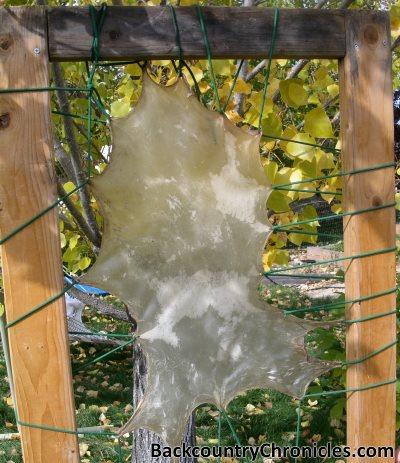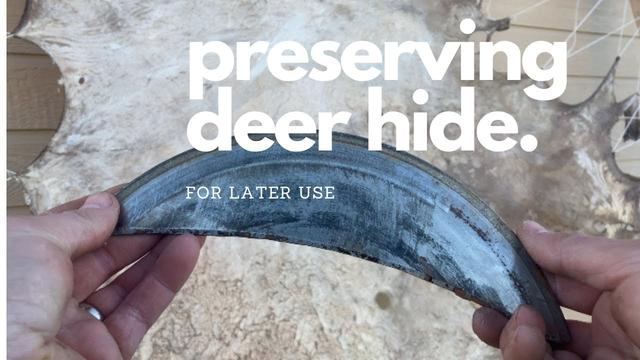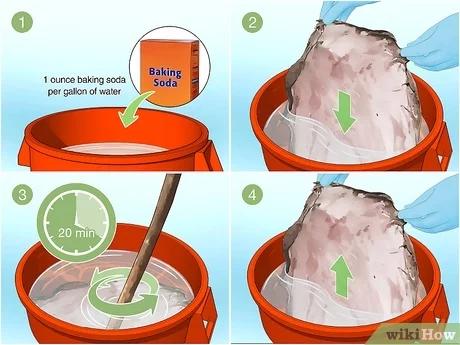Discover the artistry of deer hide: Unleash your creativity and explore endless possibilities with this versatile material. From crafting exquisite leather goods to creating stunning home decor, learn the secrets of transforming a deer hide into unique pieces that reflect your personal style. Let your imagination run wild as you delve into the world of deer hide projects and unlock its true potential.
Table of Contents
- A Step-by-Step Guide: How to Tan and Use a Deer Hide
- Maximizing Your Harvest: Creative Uses for Deer Hides
- From Field to Finished Product: Making the Most of Your Deer Hide
- Unlocking the Potential: Practical and Unique Ways to Utilize a Deer Hide
- Preserving Memories: Transforming a Deer Hide into Meaningful Keepsakes
- The Art of Tanning: Discover the Rewards of Processing Your Own Deer Hide
A Step-by-Step Guide: How to Tan and Use a Deer Hide

Tanning a deer hide is a rewarding skill that allows you to utilize every part of the animal and create high-quality leather for various projects. While it may take time and effort, the process is satisfying and worth learning. In this article, we will discuss the steps for tanning using a store-bought tanning solution.
To begin, you will need a tanning oil (such as NuTan) and several substances to adjust the pH of the hide throughout the tanning process. These include white vinegar, salt, baking soda, hydrated lime or lye, and a large plastic tub or bucket.
If you plan on tanning your hide right away, start by removing it from the deer without cutting into the skin. Trim any uneven edges or tough portions of the hide to ensure even tanning. If you need to save the hide for later, roll it up in a plastic bag and freeze it or salt it to prevent rotting.
The first step in tanning is fleshing the hide, which involves scraping off any bits of flesh or gristle. This can be messy and smelly, so protective clothing is recommended. Use a very dull blade or a fleshing knife to scrape off the flesh.
Next, remove the hair from the hide by submerging it in an alkaline solution called a “bucking” solution. You can use hydrated lime or lye to make this solution. Leave the hide submerged for a couple of days until you can easily pull out a small section of hair.
Once the hair has been removed, scrape off the grain layer underneath with firm pressure using your fleshing tool. Flip over the hide and repeat this process on the flesh side to remove any remaining bits of flesh or membrane.
After scraping, soak your hide in fresh water until it returns to a soft and flexible state. You can add ammonium sulfate to speed up this process. Once the hide is ready, prepare a pickling solution using white distilled vinegar, water, and salt. Submerge the hide in this solution for 2-3 days.
Remove the hide from the pickling solution and neutralize it by soaking it in a mixture of water and baking soda. Rinse thoroughly with fresh water and wring out any excess moisture.
Apply your tanning oil generously to both sides of the hide and let it soak in for 30 minutes. Fold the hide with the flesh side on the inside, wrap it in a tarp, and leave it overnight. The next day, wipe off any excess oil with a clean rag.
To keep the hide soft and flexible as it dries, stretch and work it every 5-10 minutes until completely dry. Hang it up or nail it to a sheet of plywood for this process.
Once dry, you will have a soft but strong piece of deer leather that can be used for various projects such as bags, gloves, tool straps, knife sheaths, and more.
Learning how to tan your own deer hides allows you to fully utilize your harvest and create unique items with your own two hands. While there are specialized tools available for tanning, you can start with basic equipment like a dull blade or hatchet. With practice and experience, you can refine your tanning skills and explore other tanning methods such as brain tanning or vegetable tanning.
Remember to always wear protective gear when working with chemicals or sharp tools during the tanning process.
Maximizing Your Harvest: Creative Uses for Deer Hides

Maximizing Your Harvest: Creative Uses for Deer Hides
Deer hunting is not just about filling the freezer with meat. It’s also an opportunity to learn new skills and make use of every part of the animal, including the hide. Learning how to tan your own deer hides can be a rewarding way to create high-quality material for various projects.
While there are services available for taxidermy or turning deer hides into wall hangings, many hunters enjoy being part of the process themselves. Tanning with a store-bought tanning solution is a great way to start, as it requires less specialized knowledge and materials compared to other methods like brain tanning or vegetable tanning.
To begin the tanning process, you will need a tanning oil (such as NuTan) and some common household items like white vinegar, salt, baking soda, hydrated lime or lye, and a large plastic tub or bucket. Specialized tools like a fleshing knife or fleshing beam can make the job easier but are not necessary.
The first step after a successful deer hunt is to skin the deer carefully. By hanging the deer and using gravity to pull the hide off, you can avoid cutting into it. Trim off any uneven edges or tough neck portions of the hide for even tanning.
If you plan to tan your hide right away, proceed with fleshing it. However, if you have other tasks to attend to first, you can preserve the hide by freezing it in a plastic bag or salting it until you’re ready.
Fleshing involves scraping off any bits of flesh and gristle from the hide’s surface. This step can be messy and smelly, so protective clothing is recommended. Any dull blade will work as a fleshing tool.
After fleshing, it’s time to remove the hair from the hide. This can be done by submerging the hide in an alkaline solution called a “bucking” solution. Hydrated lime or lye can be used to make the solution, but caution must be taken as these substances are caustic. Agitate the solution daily for a couple of days until the hair comes off easily.
Once the hair is removed, scrape off the grain layer underneath it using a fleshing tool. Flip the hide over and remove any remaining bits of flesh or membrane from the flesh side.
To return the hide to a neutral state, rinse it in fresh water and change the water regularly until it becomes soft and flexible again. Adding ammonium sulfate to the water can speed up this process.
Next, preserve the hide by submerging it in a pickling solution of vinegar and salt for 2-3 days. Then, neutralize the acidity by soaking it in a baking soda solution before rinsing thoroughly.
After wringing out excess water, apply tanning oil generously to both sides of the hide. Let it soak in overnight before wiping off any excess oil with a clean rag.
To keep the hide soft and flexible as it dries, stretch and work it every 5-10 minutes while hanging or nailed to a surface. This will open up the fibers and prevent stiffness.
Once completely dry, you’ll have a soft yet strong piece of deer leather that can be used for various projects like bags, gloves, tool straps, knife sheaths, or ax strops.
By learning how to tan your own deer hides, you can maximize your harvest and create unique items while honoring the animal you harvested.
From Field to Finished Product: Making the Most of Your Deer Hide

From Field to Finished Product: Making the Most of Your Deer Hide
When it comes to hunting, many hunters focus on filling their freezers with meat and overlook the potential of the deer hide. However, learning how to tan your own deer hides can be a rewarding skill that allows you to use every part of the animal and create beautiful, high-quality materials for various projects.
Tanning a deer hide using a store-bought tanning solution is a great starting point for beginners. You will need some common household items such as white vinegar, salt, baking soda, hydrated lime or lye, and a large plastic tub or bucket. Additionally, specialized tools like a fleshing beam and knife can make the process easier.
The first step is to remove the hide from the deer without cutting into it. Hanging the deer and using gravity to pull off the hide is recommended. Once you have the hide free, trim any uneven edges and tough neck portions for even tanning.
If you’re not planning to tan the hide immediately, you can either freeze it in a plastic bag or salt it to prevent rotting. Salting involves covering the flesh side with non-iodized salt and tightly rolling it with fur side out.
To start tanning, fleshing is necessary to scrape off any bits of flesh and gristle from the hide. This step can be messy and smelly, so protective clothing is recommended. Any dull blade or tool can be used for fleshing.
After fleshing, removing the hair from the hide is done by submerging it in an alkaline solution called “bucking.” Hydrated lime or lye can be used to make this solution. The hide should be fully submerged in the solution and agitated regularly until hair removal becomes easy.
Once all hair has been removed, scraping off the grain underneath is important for even tanning. Flip the hide over and use firm pressure with your fleshing tool to remove the grain. Rinse the hide thoroughly with fresh water.
The next step is pickling, where the hide is submerged in a solution of vinegar and salt for 2 to 3 days. This process preserves the hide. After pickling, neutralizing the acidity is necessary by soaking the hide in a baking soda solution.
After rinsing, wring out excess water and let the hide air dry until it is moist but no longer dripping. Apply tanning oil generously on both sides of the hide and let it sit overnight wrapped in a tarp. The next day, wipe off any excess oil with a clean rag.
To prevent stiffness during drying, move and stretch the hide every few minutes until it dries completely. This helps keep the fibers flexible and results in a soft but strong piece of deer leather.
Tanned deer hides can be used for various projects such as bags, gloves, tool straps, knife sheaths, and ax strops. By learning how to tan your own deer hides, you can fully utilize your harvest and create unique items with your own two hands.
Note: This information is provided as a general guide. It’s important to follow specific instructions provided by tanning solution manufacturers or seek guidance from experienced tanners for best results.
Unlocking the Potential: Practical and Unique Ways to Utilize a Deer Hide
Deer hunting is not just about filling the freezer with meat; it’s also an opportunity to learn new skills and make use of every part of the animal. One often overlooked part is the deer hide, which can be transformed into beautiful, high-quality leather for various projects. While there are services available for taxidermy or turning the hide into wall hangings, learning how to tan your own deer hides allows you to be a part of the process and provide for yourself with your own two hands.
Tanning using a store-bought tanning solution is a great starting point for beginners. You’ll need some common household items like white vinegar, salt, baking soda, hydrated lime or lye, and a large plastic tub or bucket. Specialized tools like a fleshing knife and fleshing beam can make the process easier but are not necessary.
The first step after a successful deer hunt is skinning the deer. It’s important to do this carefully to avoid cutting into the hide. Once you have the hide free, trim off any uneven edges and tough neck portions so that it tans evenly.
If you’re not planning on tanning right away, you can either freeze the hide or salt it to prevent rotting. Rolling it up in a plastic bag and labeling it before freezing is an easy option. Salting involves covering the flesh side of the hide with non-iodized salt and rolling tightly with fur side out. Store in an airtight container until ready for tanning.
The next step is fleshing the hide by scraping off any bits of flesh or gristle. This can be messy and smelly, so protective clothing is recommended. Any dull blade will work as a fleshing tool.
After fleshing, it’s time to remove the hair from the hide by soaking it in an alkaline solution called a “bucking” solution. Hydrated lime or lye can be used to make the solution, but caution should be taken as these are caustic substances. Agitating the hide in the solution for a couple of days will loosen the hair fibers, making it easier to remove.
Once the hair is removed, the hide needs to be neutralized and rinsed. This involves soaking it in fresh water until it returns to a soft and flexible state. Adding ammonium sulfate can speed up this process.
To preserve the hide, it needs to be pickled in an acid and salt solution. White distilled vinegar and salt are commonly used for this step. After pickling, the hide is neutralized again with a baking soda solution and thoroughly rinsed.
Finally, tanning oil is applied to the hide to preserve and soften it. The hide is folded with the flesh side on the inside and left overnight for the oil to soak in. Excess oil is wiped off, and then the hide is stretched and worked while drying to keep it soft and flexible.
Tanned deer hides can be used for various projects like bags, gloves, tool straps, knife sheaths, or ax strops due to their toughness and flexibility. By utilizing every part of the deer you harvest, you not only gain valuable skills but also feel a sense of satisfaction knowing that nothing goes to waste.
Preserving Memories: Transforming a Deer Hide into Meaningful Keepsakes

Preserving Memories: Transforming a Deer Hide into Meaningful Keepsakes
One of the first steps after a successful deer hunt is skinning your deer, but often the skin itself becomes an afterthought as you focus on processing the meat. However, learning how to tan your own deer hides can be a rewarding way to use every part of the animal and create beautiful, high-quality material for various projects.
Tanning with a store-bought tanning solution is a great starting point for beginners. You will need some common household items like white vinegar, salt, baking soda, hydrated lime or lye, and a large plastic tub or bucket. Specialized tools like a fleshing beam and knife can make the process easier but are not necessary.
The first step is to remove the hide from the deer without cutting into it. Once you have the hide free, trim off any uneven edges and tough portions so it tans evenly. If you’re not tanning right away, you can freeze the hide or salt it to preserve it.
To tan the hide, start by fleshing it to remove bits of flesh and gristle. This can be messy and smelly, so protective clothing is recommended. Next, use a “bucking” solution with an alkaline substance like hydrated lime or lye to remove the hair from the hide easily.
After scraping off all the hair and grain from both sides of the hide, return it to a neutral state by soaking it in fresh water. You can add ammonium sulfate as a deliming agent to speed up this process. Once neutralized, pickle the hide in an acidic solution of vinegar and salt for 2-3 days.
After pickling, neutralize the hide again with baking soda solution and rinse thoroughly. Wring out excess water and apply tanning oil generously on both sides of the hide. Let it sit overnight before wiping off any excess oil.
To dry the hide, stretch and work it regularly to keep the fibers flexible. Hang it up or nail it to a surface and continue stretching and working it until completely dry. Once dry, you will have a soft yet strong piece of deer leather that can be used for various projects.
Tanning your own deer hides allows you to be part of the process and create meaningful keepsakes from your hunts. From bags and gloves to tool straps and knife sheaths, tanned deerskin can be used for a wide range of applications. So embrace the opportunity to learn this skill and make the most of your harvest.
The Art of Tanning: Discover the Rewards of Processing Your Own Deer Hide

The art of tanning your own deer hide is a rewarding and fulfilling process that allows you to utilize every part of the animal. While many hunters may send their hides to be taxidermied or turned into wall hangings, there is something special about being able to make something with your own two hands. Learning how to tan your own deer hides not only allows you to use every part of the animal but also results in a beautiful, high-quality material that can be used for various projects.
Tanning with a store-bought tanning solution is considered the perfect “gateway” tanning process as it requires less specialized knowledge, time, and material gathering compared to other methods such as brain tanning or vegetable tanning. You can easily purchase a tanning solution online or at hunting gear stores.
In addition to the tanning oil, you will need several substances to alter the pH of your hide throughout the tanning process. These include white vinegar, salt, baking soda, hydrated lime or lye, and a large plastic tub or bucket. While there are specialized tools available for tanning, such as a fleshing beam and fleshing knife, you can use alternatives like a sawhorse and dull blade if needed.
The first step in tanning your deer hide is removing it from the deer without cutting into the hide itself. Hanging the deer and using gravity to pull off the hide is recommended. Once removed, trim any uneven edges and tough neck portions for even thickness during tanning.
If you plan on tanning immediately, proceed with fleshing the hide by scraping off any bits of flesh and gristle. This step can be messy and smelly, so protective clothing is advised. If you have other tasks to attend to before tanning, you can either freeze the hide in a plastic bag or salt it to prevent rotting until you’re ready.
After fleshing, it’s time to remove the hair from the hide. This can be done by placing the hide in an alkaline solution, known as a “bucking” solution, which causes the hair fibers to slide out easily. Hydrated lime or lye can be used to make the solution alkaline. The hide should be fully submerged and agitated regularly for a couple of days until the hair comes out easily when tested.
Once the hair is removed, you will need to scrape off the grain underneath using a fleshing knife or alternative tool. Flip the hide over and remove any remaining bits of flesh or membrane from the flesh side. Afterward, soak the hide in fresh water until it returns to a soft and flexible state.
To preserve the hide, it needs to be pickled by submerging it in an acidic and salt solution. White distilled vinegar mixed with water and salt is commonly used for this step. Leave the hide in the pickling solution for 2-3 days before neutralizing it with a baking soda solution and rinsing thoroughly.
Finally, apply your tanning oil to both sides of the hide and let it soak in overnight. Remove any excess oil with a clean rag before drying your hide while stretching and working it periodically to keep it soft and flexible.
Once completely dry, your deer hide will be ready for use in various projects such as bags, gloves, tool straps, knife sheaths, or ax strops. The process may take time and effort but knowing that you have utilized every part of your harvest is incredibly satisfying.
In conclusion, there are several options for what to do with a deer hide. It can be tanned and turned into various useful products such as clothing, bags, or rugs. Alternatively, it can be donated to organizations that use animal hides for educational purposes or conservation efforts. Whatever the choice may be, recycling and repurposing deer hides helps ensure that no part of the animal goes to waste.












































